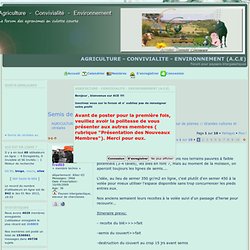

Bug Blaster - BSF Farming. Elevages d’insectes : quels sont les différents types d'élevage ? - InsectesComestibles.fr. Breeding insects can be made at home or inside big industrial farms.

Usually exerted with passion even if it is for commercial purposes, breeding insect is a new and innovative way to save the world. Insects are important for our ecosystem. They clean, recycle and fertilize the soil by eating dead plants and animal wastes. They even provide fertilizer by way of the wastes they themselves release, which in turn boost humus growth in the soil. Insects can also move pollen from flower to flower, pollinating them. Insects fill an essential role in our food chain, especially as a main source of food for many other animals. Domestic breeding of bugs Breeding bugs for practical purposes The best known reason for breeding bugs is beekeeping. Bugs can be bred purely beneficial for biological warfare Crops are usually safeguarded from parasites by predator insects such as the ladybug. Bugs bred for educational or scientific purposes Breeding insects for the hell of it The Chinese example.
Technical/Instructional. Many people have asked if they can buy The Scythe Book from us.

We do not sell it; instead, chapters from The Scythe Must Dance (the "Addendum" we wrote in 2001) are posted below, free for reading and printing. They are revised, as should be the case from time to time with any instructional text written by anyone who is still learning. Normally this would be accomplished in co-operation with the publisher whenever another printing of the original is made. However, we were not given the opportunity to do so, even though other printings were made since its initial publication, and we have therefore opted to make the improved material accessible free of charge.
Faux - Coop Outils TV. How often do you find yourself using a tool which, in one form or another, dates back at least a millennia, and yet which outperforms its modern equivalents in pretty much every way that matters?

How often do you find yourself using a tool whose basic principle can be traced back almost to the dawn of agriculture, and yet which, with a lot of smart but fairly minimal modernisation along the way, is still in use globally because it still works? And what are the chances of this tool also being physically beautiful object, and a delight to use? I've been using a scythe for six or seven years now, and every year that has passed has seen my mild but pleasing addiction to it growing. Quietly, but in growing numbers, there are a lot of people like me now around Britain. We are like people who have discovered a new band and want to tell the world about it, but at the same time want to keep it to ourselves for fear it will be ruined. Scything: the rebirth Two Austrian scythes My life with scythes. Semis de céréales à la volée. Semis de céréales à la volée par fred03 le Mar 03 Aoû 2010, 22:13 Les triticales ne tallent pas suffisamment dans nos terrains pauvres à faible potentiels (3-4 talles), les blés en font 7, mais au moment de la moisson, on apercoit toujours les lignes de semis....

L'idée, au lieu de semer 350 gr/m2 en ligne, c'est plutôt d'en semer 450 à la volée pour mieux utiliser l'espace disponible sans trop concurrencer les pieds entres eux. Semis à la volée ou par recouvrement les techniques s’affinent jusqu’au semis dans les couverts. Cela fait plusieurs années que la revue TCS aborde le sujet du semis à la volée, appelé également semis par recouvrement (TCS n° 29 de septembre/octobre 2004 et n° 39 de septembre-octobre 2006).

Et pour cause : cette approche est tout à la fois très économique, rapide et simple. Chacun y a goûté au moins une fois lors de conditions difficiles où l’on ne pouvait plus faire autrement pour semer ses blés. On sortait alors l’épandeur à engrais de l’exploitation et l’outil de déchaumage habituel. Technique ancienne, utilisée par nos grands-parents, son principe consiste à semer les grains à la volée à la surface du sol et à les recouvrir ensuite de terre et/ou de mulch. Elle utilise ainsi la faculté qu’ont de nombreuses semences, surtout celles de petite taille, de germer en surface. Besoins d’humidité La plupart des agriculteurs qui sèment à la volée déchaument au préalable parfois deux voire trois fois.